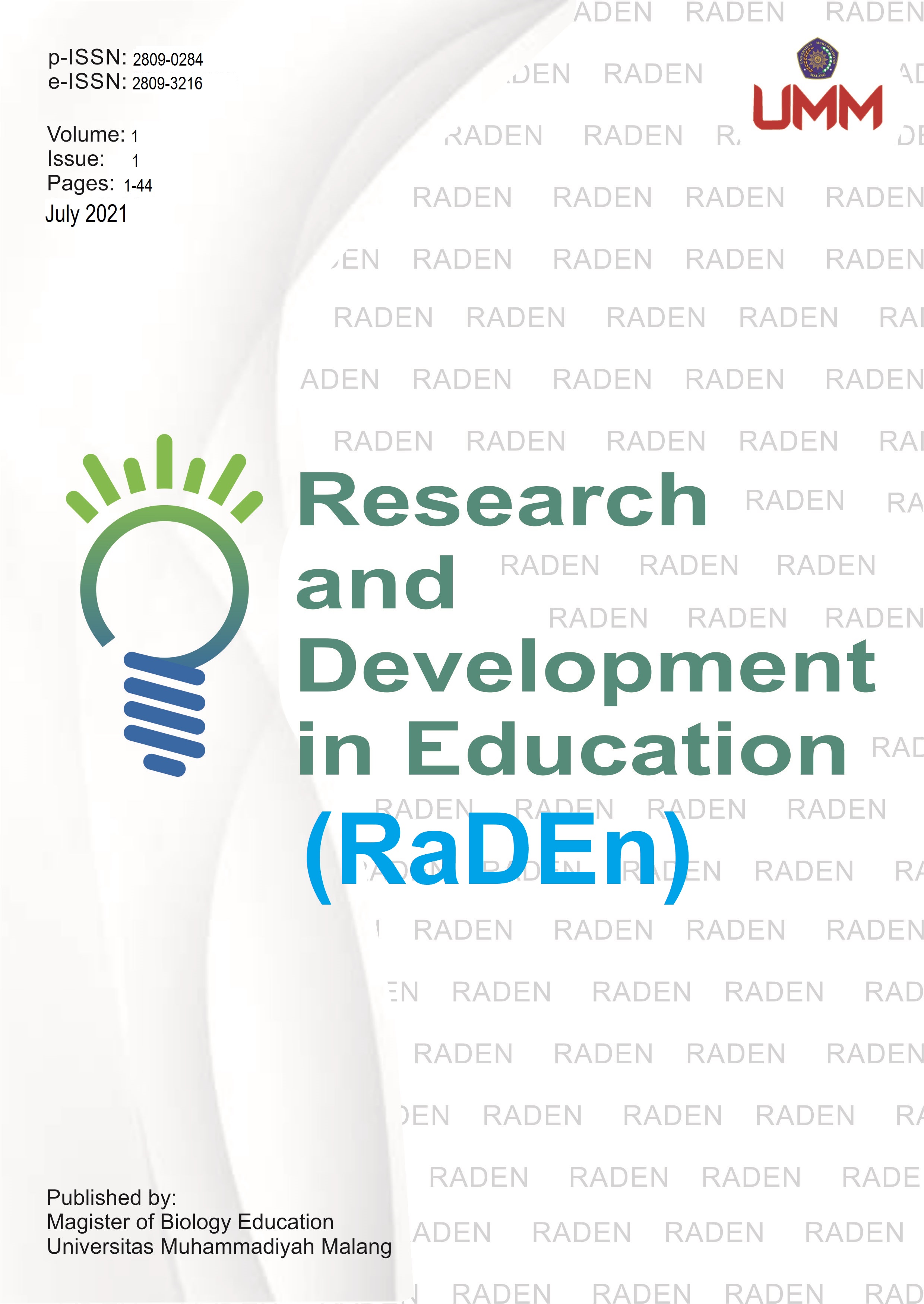Development of comics as a learning media on human digestive system topic
DOI:
https://doi.org/10.22219/raden.v1i1.18491Keywords:
comic, human digestive system, learning mediaAbstract
The human digestive system is a difficult subject for high school students. The purpose of this research was to develop comics as a learning media on the human digestive system topic. The development of comics used the Sugiyono model which consists of the stages of identifying potentials and problems, data collection, product design, design validation, design revision, product testing, product revision, usage testing, and product revision. The participants involved in the product trial were seventh grade students of SMP Diponegoro and SMP Raden Fatah in Batu City. The data collection instruments used were validation sheets and test sheets. The results of the validation from content and media experts inform that comics were included in the appropriate category. The average of students' posttest results were always greater than the pretest, both on small-scale and large-scale trials. Student responses to comics were also categorized as very positive. In conclusion, the comics developed are effective and feasible to use.
Downloads
References
Arikunto, S. (2013). Prosedur penelitian suatu pendekatan praktik. Edisi Revisi. Rineka Cipta. https://www.belbuk.com/prosedur-penelitian-suatu-pendekatan-praktik-p-1806.html
Budiarti, W. N., & Haryanto, H. (2016). Pengembangan media komik untuk meningkatkan motivasi belajar dan keterampilan membaca pemahaman siswa kelas IV. Jurnal Prima Edukasia, 4(2), 233–242. https://doi.org/10.21831/jpe.v4i2.6295
Hasyim, M. (2014). Penerapan fungsi guru dalam proses pembelajaran. Jurnal Auladuna, 1(2), 265–276. http://journal.uin-alauddin.ac.id/index.php/auladuna/article/view/556
Hidayah, N., & Ulva, R. K. (2017). Pengembangan media pembelajaran berbasis komik pada mata pelajaran ilmu pengetahuan sosial kelas IV MI Nurul Hidayah Roworejo Negerikaton Pesawaran. Jurnal Pendidikan Dan Pembelajaran Dasar, 4, 34–46. https://doi.org/10.24042/terampil.v4i1.1804
Riduwan, R. (2013). Dasar-dasar statistika. cv alfabeta. https://cvalfabeta.com/product/dasar-dasar-statistika/
Sadiman, A. S., Rahardjo, R., Haryono, A., & Rahardjito, R. (2009). Media pendidikan. PT. Raja Grafindo Persada. https://www.rajagrafindo.co.id/produk/media-pendidikan/
Slavin, R. (2019). Psikologi pendidikan: teori dan praktik (terjemahan). PT Indeks. https://opac.perpusnas.go.id/DetailOpac.aspx?id=1214788
Sugiyono, S. (2019). Metode penelitian kuantitatif kualitatif dan R&D. cv alfabeta. https://cvalfabeta.com/product/metode-penelitian-kuantitatif-kualitatif-dan-rd-mpkk/
Sungkono, S. (2008). Pemilihan dan penggunaan media dalam proses pembelajaran. Majalah Ilmiah Pembelajaran, 4(1), 71–80. https://journal.uny.ac.id/index.php/mip/article/view/6878
Supartini, M. (2016). Pengaruh penggunaan media pembelajaran dan kreativitas guru terhadap prestasi belajar siswa kelas tinggi di SDN Mangunharjo 3 Kecamatan Mayangan Kota Probolinggo. Jurnal Penelitian Dan Pendidikan IPS (JPPI), 10(2), 277–293. https://ejournal.unikama.ac.id/index.php/JPPI/article/view/1721
Downloads
Published
How to Cite
Issue
Section
License
Copyright (c) 2021 Nuraini et al

This work is licensed under a Creative Commons Attribution-ShareAlike 4.0 International License.
Authors who publish with Research and Development in Education agree to the following terms:
- For all articles published in the Research and Development in Education, copyright is retained by the authors. Authors give permission to the publisher to announce the work with conditions. When the manuscript is accepted for publication, the authors agree to the automatic transfer of non-exclusive publishing rights to the publisher.
- Authors retain copyright and grant the journal right of first publication with the work simultaneously licensed under a Creative Commons Attribution-ShareAlike 4.0 International License that allows others to share the work with an acknowledgment of the work's authorship and initial publication in this journal.
- Authors are able to enter into separate, additional contractual arrangements for the non-exclusive distribution of the journal's published version of the work (e.g., post it to an institutional repository or publish it in a book), with an acknowledgment of its initial publication in this journal.
- Authors are permitted and encouraged to post their work online (e.g., in institutional repositories or on their website) prior to and during the submission process, as it can lead to productive exchanges, as well as earlier and greater citation of published work (See The Effect of Open Access).

This work is licensed under a Creative Commons Attribution-ShareAlike 4.0 International License.








